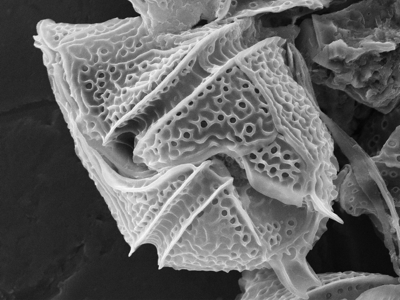Posted on Point Reyes Light: 13 December 2011 — Clues to Northern California Shellfish Die-off. By Ryan Jacobs
 Courtesy of Charles O’Kelly
Courtesy of Charles O’Kelly
Once in a great while, a biologist finds herself at the confluence of a rare natural phenomenon. This often involves decades, or even whole careers, of observing and waiting in forests, deserts or coves for something—anything—to happen, if it ever happens at all.
Sonoma State University biology graduate student Adele Paquin eluded years of quiet drudgery for a serendipitous moment that came only two-and-a-half years into her research career. After spending the early parts of August dipping plastic bottles and mesh nets into Bodega Bay for phytoplankton samples and preserving them in Lugol’s iodine solution as part of a Master’s thesis project, Paquin watched as an algal bloom materialized late in the month and coincided with die-offs of red abalone, sea urchin, mussels and a number of other marine species up and down the Sonoma coast. The die-offs prompted the Department of Fish and Game to close the abalone diving season early.
“At the time that it happened, I just thought it was another bloom,” Paquin said. “It was sort of this slow realization that these samples are actually really important. I just felt really grateful because this was totally an unexpected event. It just happened that I captured something critical.”
The specimens that Paquin collected before, during and after the event could explain the link between the algal blooms and the invertebrate deaths and could potentially reveal a new “cryptic” species of phytoplankton.
The vast blooms and widespread die-offs were unprecedented on the northern coast of California, where phytoplankton have been relatively under-studied and sampled. “I’ve never seen an algal bloom affect this suite of organisms,” Sonoma biology professor and Paquin’s advisor, Karina Nielsen, said. “It’s a very unusual and singular event in the science of harmful algal blooms.”
When Paquin first consulted Nielsen, she had done a cursory phenotypic analysis of the samples and believed the dominant species to be Gonyaulax digitale, a member of the group called the dinoflagellates. However, Gonyaulax digitale wasn’t known to produce toxins that harmed marine life.
Nielsen suggested that Paquin go back to the samples and do comparisons with a similar species within the same genus called Gonyaulax spinifera, which was known to produce yessotoxins that have killed marine life off the shores of New Zealand and in the Adriatic Sea.
Meanwhile, the researchers ruled out oxygen deprivation, viruses and bacteria as causes by analyzing water samples from the area. “Its kind of like a marine biology CSI,” Nielsen said. “We have all these pieces of evidence. All the dots have not been connected.”
After reexamining the samples and concluding that they were indeed part of the Gonyaulax spiniferaspecies complex, the Sonoma researchers sent them to the University of Washington’s Friday Harbor Laboratories algae and protozoa expert Charles O’Kelly to confirm their analysis.
“My role is to make sure we know exactly what it is,” O’Kelly said. “Before we know what it made, we need to know what it is. And that’s not easy because there are ten times more kinds of algae out there than we have names for. So, we know every whale in the ocean on a first name basis, but we don’t even know 90 percent of the algae in the world.”
Using a scanning electron microscope, which magnifies details to the cellular level, O’Kelly verified that this particular species was a member of the Gonyaulax spinifera species complex. Based on the fact that there were small differences between the Sonoma spinifera samples and those collected elsewhere, he thinks it’s a member species that’s never been discovered before, but would like to wait for DNA analysis to say it with certainty.
“If you put me in front of a Las Vegas betting table, I would put my money on this one being new,” he said. “Right now that’s where my money would be going.” Currently, the scientists are securing funding to pull DNA out of the preserved samples and establish the mapping of what they think is a distinct genotype.
“Once we have the genetic signature, we can use that information to readily and more quickly test the waters in the future and to figure out which species may be involved in a subsequent public health event,” Nielsen said. “It can lead to quick, good information about what people should do.” The DNA analysis would take roughly six months to complete.
On a more long-term basis, the scientists want to analyze the preserved cysts and culture them to produce their toxins, which they could then study to determine whether the chemical structures are distinct from those of the yessotoxin.
“Some of the ways that it’s interacted with the animals raises suspicion about whether yessotoxin could be the causative agent or not,” Nielsen said. “Yessotoxin accumulates in fat but some of these animals don’t eat seaweed. It could be something else, an unknown toxin that we haven’t been able to screen for.”
For all the groundbreaking discoveries that they’ve overseen, the researchers aren’t interested in attaching their names to the potential new species. “It’s much more important for me to get the science out that would help us understand the bloom,” O’Kelly said.
Nielsen agreed. “It should be named after the organism you’re looking at,” she said. “I’m not in the camp that likes naming it after people.”
Paquin said the whole experience has reminded her of the importance of having a consistent presence in the field. “This was sort of a real world lesson of how important it is to be regularly monitoring the coastal environment,” she said. “I just kind of got lucky.”
Read the article here.